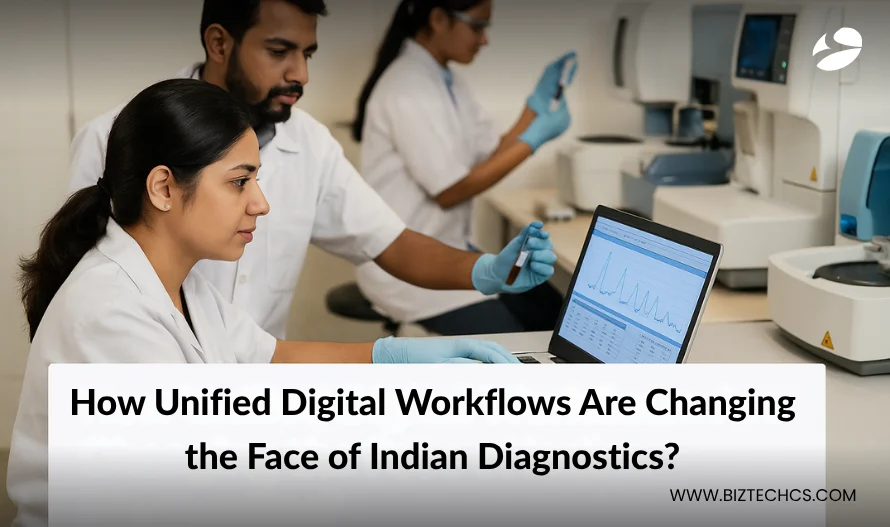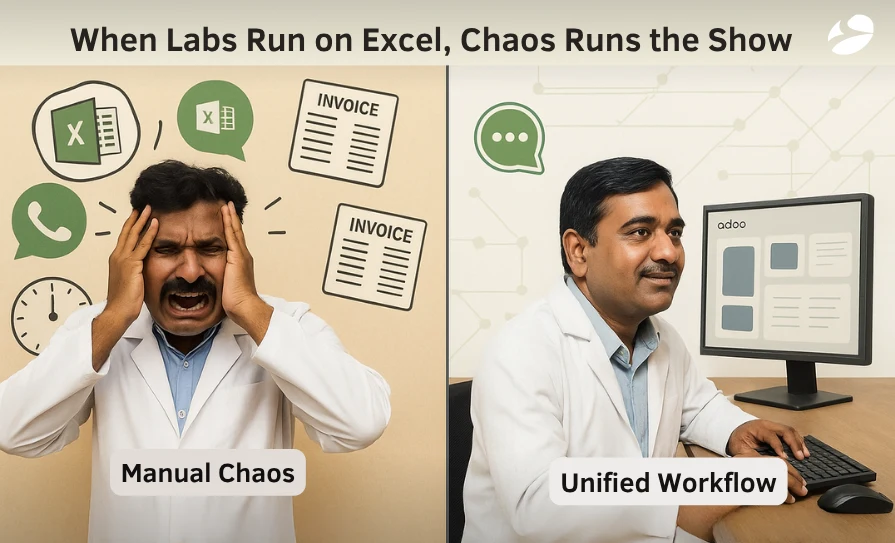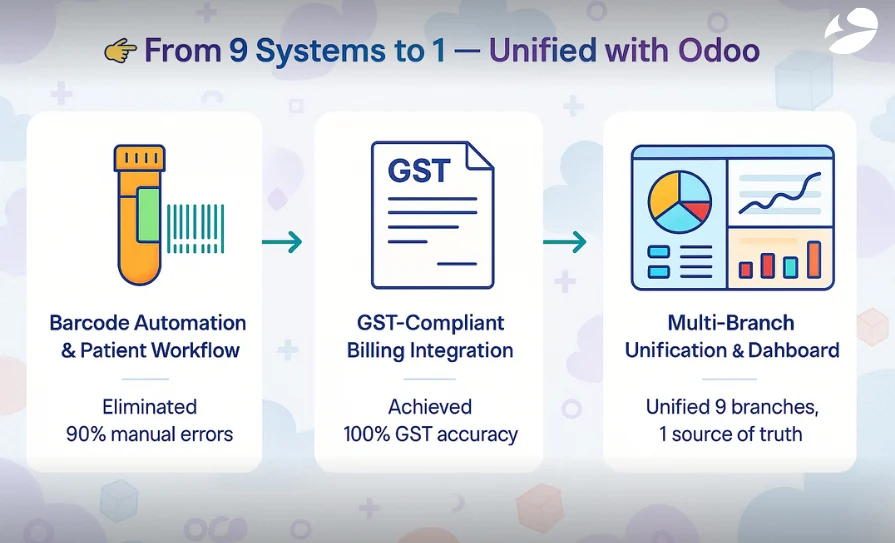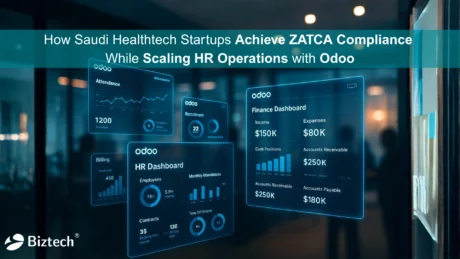323
How Unified Digital Workflows Are Changing the Face of Indian Diagnostics?
16 Oct, 2025
5 min read
323
16 Oct, 2025
5 min read

India’s diagnostics market is on track to reach USD 28.4 billion by 2033, growing at 11.21% CAGR (IMARC Group). Yet, most labs are still running on WhatsApp updates and Excel sheets that would make a 1995 accountant weep with nostalgia.
“If digitization promises efficiency, why are so many labs still stuck in operational quicksand?” — That’s the question many COOs whisper just before another monthly review where turnaround time targets go unmet. The reality is, disconnected systems don’t just slow things down; they silently drain profitability and patient confidence.
When a Mumbai-based diagnostic chain with nine centers discovered their staff was spending more time hunting for sample tracking sheets than actually processing samples, they knew something had to give (spoiler alert: it was their sanity).
Picture this delightful scenario: patients waiting three hours for reports that should take thirty minutes, invoices that match GST requirements as well as oil mixes with water(!), and lab technicians playing detective, trying to figure out which Excel file has the latest patient data.
The COO’s confession hit the nail on the head when he admitted that losing track of samples or botching invoices doesn’t just burn revenue; it torches the one thing money can’t buy back — patient trust.
Between the manual data entry marathon and the GST compliance circus, these labs were essentially running a three-legged race while blindfolded, wondering why they kept falling flat on their faces.
That’s precisely when BiztechCS an experienced odoo ERP development company can enter the scene, not with another band-aid solution, but with an Odoo-powered transformation that connects patients, labs, and finance into one seamless ecosystem.
Think of it as trading in your rickety bicycle for a Tesla; suddenly, the journey from sample collection to invoice generation becomes less of an obstacle course and more of a smooth highway where everything just works.
The paradox of Indian diagnostic labs reads like a bad comedy script: they’re drowning in patient samples while simultaneously having no clue where half of them are — proving that you can indeed be busy and lost at the same time.
“Can chaos really coexist with growth?” A lab owner from Pune once asked this while staring at dashboards that looked more like abstract art than analytics. The uncomfortable truth: yes — if growth isn’t backed by integration. Scaling disconnected systems only magnifies the disorder.
Labs still tracking samples in Excel spreadsheets from 2010, billing through Tally (because why not add another layer of complexity?), and patient records floating somewhere in between like ships passing in the night have created what experts politely call a “Data Bermuda Triangle.”
Despite growing automation efforts, studies show that manual processing steps still dominate in many labs — and automation could reduce these by up to 86%, dramatically improving accuracy and turnaround times (Medical Buyer).
The real kicker comes when auditors arrive and lab managers scramble to connect sample ID #4523 to patient Mr. Sharma’s invoice from three months ago, only to discover that both exist in completely different universes with zero way to bridge them. “So what’s the real cost of this disconnect — just operational chaos or something deeper?” In truth, it’s both—every mismatch chips away at compliance integrity, patient trust, and ultimately, brand reputation.
Odoo Consultant Tip: Here’s what we recommend at BiztechCS map your data flows before touching Odoo. First, draw how sample IDs connect to patients and invoices on paper. Trust us, this 2-hour exercise saves weeks of rework because Odoo’s database loves relationships that actually make sense. When paired with expert Odoo Customization Services, this approach ensures every workflow, field, and module aligns perfectly with your lab’s real-world operations.
When data silos run the show, accountability takes a backseat, and compliance becomes a gamble rather than a guarantee. This operational circus doesn’t just delay reports by hours or days; it turns compliance into a game of Russian roulette where every GST filing feels like defusing a bomb with oven mitts on.
BiztechCS can step into this chaos with a unified digital workflow that treats sample tracking, patient records, and invoices like they actually belong in the same conversation (revolutionary concept, right?). The result? Audit-ready data that makes compliance officers weep tears of joy instead of despair.
When every test automatically syncs with its report and invoice, labs suddenly discover they can focus on what matters — processing samples accurately instead of playing hide-and-seek with their own data.

Managing samples and invoices separately in a diagnostic lab is like trying to conduct an orchestra where the violins are in Mumbai and the drums are in Delhi, then acting shocked when the symphony sounds like a cat fight.
When duplicate barcodes start multiplying faster than gossip in a corporate cafeteria, and GST tags attach to invoices with the precision of a toddler coloring outside the lines, you know the system has gone rogue.
“Isn’t this just a technology issue that better training could fix?” A fair question — but far from the truth. The root problem isn’t human error; it’s systemic fragmentation. When workflows are designed around disjointed tools, even the best-trained staff are fighting uphill battles.
BiztechCS can not only understand this but also rebuild the foundation using Odoo dependencies, making every invoice traceable back to verified sample data.
The finance head’s brilliant suggestion to “fix billing first” without addressing sample tracking is the business equivalent of putting lipstick on a pig and calling it Miss Universe. BiztechCS will break the news that invoices must originate from validated sample data, not be conjured from thin air and wishful thinking.
By structuring Odoo dependencies where every invoice automatically inherits its DNA from the right patient and test data, the entire workflow transforms from a game of broken telephone into a coherent conversation where everyone’s finally speaking the same language.
Does your billing team struggle to match invoices with the right patient tests while maintaining GST compliance? A unified system could turn your invoicing nightmare into an automated dream.
We will approach the challenge in structured phases, transforming lab operations from chaos to clarity.
We’ll start by customizing Odoo Healthcare and Lab modules specifically for India’s operational circus, because off-the-shelf solutions work about as well as using Google Translate for your wedding vows.
Next, we’ll introduce barcode-linked sample IDs that generate automatically at collection centers, establishing our cardinal rule: “Never let collection staff manually type sample IDs” — we’ve seen typos multiply like rabbits in monsoon season.
To make all this work seamlessly, our Odoo Integration Services will connect patient data, billing, and logistics systems into one cohesive flow — ensuring automation doesn’t just exist, it adds value.
“But would automation make my frontline staff feel replaced or empowered?” It’s a question every healthcare COO wrestles with during digital transformation. What we typically find is the opposite of resistance — when automation eliminates repetitive manual drudgery, staff morale spikes.
The barcode automation we can implement will slash manual entry errors by 90%, transforming collection staff from frustrated data-entry clerks into actual healthcare workers who could look patients in the eye instead of squinting at keyboards.
Odoo Consultant Tip: Make Odoo beep when barcodes scan successfully — sounds silly but speeds up collection by 30%. Also, create a template for the IDs using an auto-generated sequencing of the numbers, such as – MUM-20240115-001 (location-date-number). Your staff will thank you when they’re not typing random 16-digit codes while patients glare at them.
Our validation rules became the gatekeepers, bouncing duplicate entries and missing data faster than a nightclub rejecting underdressed patrons on New Year’s Eve. We won’t just digitize their workflow; we’ll rescue them from the special hell of typing 16-digit alphanumeric codes while angry patients tapped their feet in the waiting room.
We’ll tackle GST compliance like surgeons approaching a particularly nasty tumor, because Indian healthcare GST rules read like they were written by someone who enjoys watching accountants cry.
We’ll integrate invoices directly with patient and test records, ending the bizarre tradition where billing systems lived in complete isolation, communicating with other systems about as effectively as teenagers with their parents.
“How do you ensure financial accuracy when healthcare data is constantly changing?” That’s where integration becomes the unsung hero. By designing a data flow where every invoice inherits its accuracy from patient and test data, we turned moving targets into structured, auditable entries.
Our system automatically separated exempt pathology tests from taxable consumables, sparing the accounting team from their daily ritual of consulting three different circulars, two CA opinions, and a crystal ball to figure out tax classifications.
Our system automatically separated exempt pathology tests from taxable consumables, sparing the accounting team from their daily ritual of consulting three different circulars, two CA opinions, and a crystal ball to figure out tax classifications. We can develop custom accounting rules that will achieve what many call impossible: zero GST filing errors and compliance so clean it would make a Swiss banker jealous.
The dual reporting views we can create will finally allow finance teams to see clinical revenue and taxable income separately, answering questions they’ve been asking since GST rolled out in 2017 and turned their lives into a perpetual math problem.
Is your finance team still manually sorting exempt pathology tests from taxable consumables every month? Automated GST compliance could give them back weeks of productive time.
We can bring nine branches under one digital umbrella by configuring branch-wise Odoo environments with a unified Chart of Accounts. Running nine different systems is like hosting a dinner party where each guest speaks a different language, and nobody brought Google Translate.
We’ll design dashboards that show sample turnaround times for each location in real-time, transforming what used to be monthly post-mortems into daily vital signs that operations could actually act on.
Our automated daily reconciliation can turn month-end from a week-long hostage situation (where finance teams survived on coffee and prayer) into a civilized process that respects human working hours.
We’ll deliver centralized reporting that provides leadership with one version of the truth, rather than nine competing narratives that agreed as often as relatives at a family reunion discussing politics.
This wasn’t just systems integration; we performed organizational therapy that got all nine branches reading from the same playbook, probably for the first time since the company opened its second location.

Within 60 days of go-live, you can watch the chaos transform into choreography with numbers that made even the skeptics sit up straight:
When operations heads tell us, ‘For the first time, patients, accountants, and doctors are on the same system, that’s priceless,’ we know we can achieve something special: proving that enterprise digitization doesn’t have to feel like organizational root canal surgery.
We won’t just implement software; we’ll restore sanity to an industry where Excel sheets and WhatsApp had somehow become mission-critical infrastructure, and everyone involved lived to tell the tale.
The diagnostics industry runs on precision, yet most labs are still managing operations with spreadsheets that have more formula errors than a failed chemistry exam, proving that irony is alive and thriving in healthcare.
BiztechCS transforms this manual circus into synchronized digital care using Odoo, because watching labs juggle Excel sheets, WhatsApp messages, and Tally entries is entertaining for exactly nobody, especially not the patients waiting for their reports.
When patient records, lab operations, and billing finally speak the same language under one system, something magical happens: labs can actually focus on analyzing samples instead of analyzing why their data doesn’t match.
Let BiztechCS map your diagnostic journey from blood sample to GST invoice with the kind of precision that would make a Swiss watchmaker nod in approval, because we understand that in diagnostics, “close enough” is about as acceptable as “mostly sterile.”
We’ll implement your Odoo roadmap one branch and one workflow at a time, turning your operational chaos into a symphony where every note (or in this case, every sample) hits perfectly. Think of it as trading your rickety bicycle for a Formula One car; sure, both will get you there eventually, but only one will get you there with your sanity intact and your compliance officer actually smiling.
The best part? Your patients will stop asking why their reports take longer than Amazon deliveries, and your finance team will finally sleep through the night without GST nightmares.
Is your diagnostic lab ready to trade operational chaos for digital precision? Every day spent juggling disconnected systems is another day of lost revenue and frustrated patients waiting for a transformation that’s already within reach.

Odoo
91
By Uttam Jain
28 Nov, 2025

Artificial Intelligence (AI)
153
By Afzal Qureshi
27 Nov, 2025

Odoo
110
By Uttam Jain
27 Nov, 2025